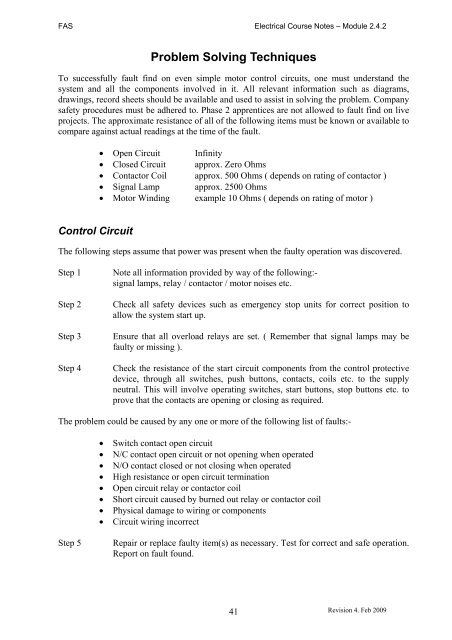Trade of Electrician Motor Control COURSE NOTES - eCollege
Trade of Electrician Motor Control COURSE NOTES - eCollege
Trade of Electrician Motor Control COURSE NOTES - eCollege
Create successful ePaper yourself
Turn your PDF publications into a flip-book with our unique Google optimized e-Paper software.
FAS Electrical Course Notes – Module 2.4.2<br />
Problem Solving Techniques<br />
To successfully fault find on even simple motor control circuits, one must understand the<br />
system and all the components involved in it. All relevant information such as diagrams,<br />
drawings, record sheets should be available and used to assist in solving the problem. Company<br />
safety procedures must be adhered to. Phase 2 apprentices are not allowed to fault find on live<br />
projects. The approximate resistance <strong>of</strong> all <strong>of</strong> the following items must be known or available to<br />
compare against actual readings at the time <strong>of</strong> the fault.<br />
<strong>Control</strong> Circuit<br />
Open Circuit Infinity<br />
Closed Circuit approx. Zero Ohms<br />
Contactor Coil approx. 500 Ohms ( depends on rating <strong>of</strong> contactor )<br />
Signal Lamp approx. 2500 Ohms<br />
<strong>Motor</strong> Winding example 10 Ohms ( depends on rating <strong>of</strong> motor )<br />
The following steps assume that power was present when the faulty operation was discovered.<br />
Step 1 Note all information provided by way <strong>of</strong> the following:-<br />
signal lamps, relay / contactor / motor noises etc.<br />
Step 2 Check all safety devices such as emergency stop units for correct position to<br />
allow the system start up.<br />
Step 3 Ensure that all overload relays are set. ( Remember that signal lamps may be<br />
faulty or missing ).<br />
Step 4 Check the resistance <strong>of</strong> the start circuit components from the control protective<br />
device, through all switches, push buttons, contacts, coils etc. to the supply<br />
neutral. This will involve operating switches, start buttons, stop buttons etc. to<br />
prove that the contacts are opening or closing as required.<br />
The problem could be caused by any one or more <strong>of</strong> the following list <strong>of</strong> faults:-<br />
Switch contact open circuit<br />
N/C contact open circuit or not opening when operated<br />
N/O contact closed or not closing when operated<br />
High resistance or open circuit termination<br />
Open circuit relay or contactor coil<br />
Short circuit caused by burned out relay or contactor coil<br />
Physical damage to wiring or components<br />
Circuit wiring incorrect<br />
Step 5 Repair or replace faulty item(s) as necessary. Test for correct and safe operation.<br />
Report on fault found.<br />
41<br />
Revision 4. Feb 2009

















